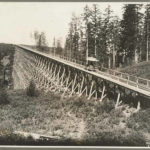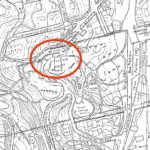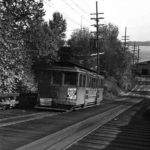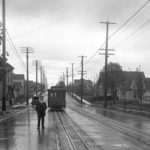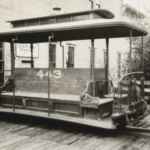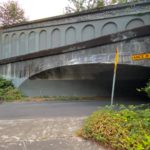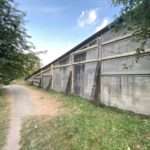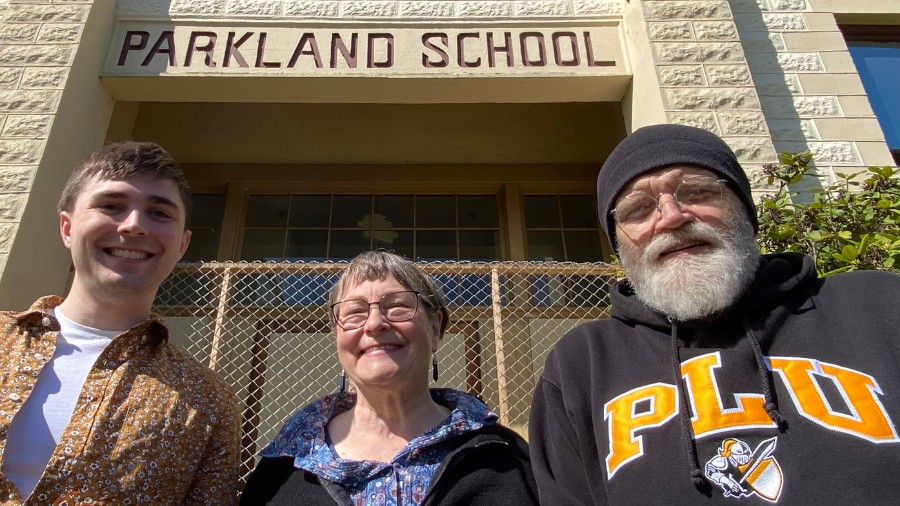Unwinding the history of the old Yesler Cable Car
Aug 5, 2020, 12:08 PM | Updated: 12:08 pm
Trolleys and street cars have a long and tortured relationship with Seattleites – including at the ballot box – which is worth noting this week of the primary election.
And it’s pretty much forgotten that this tortured relationship included, once upon a time, San Francisco-style cable cars serving as part of the public transit mix in the Emerald City of not that long ago.
In fact, it was 80 years ago this week, very early on the morning of Saturday, Aug. 10, 1940, when the old Yesler Cable Car ended its final run after 52 years of hauling people back and forth between Pioneer Square and the dance hall and ferry dock at Leschi Park on Lake Washington.
The Yesler route was the last of the Seattle cable cars to go — after the Madison and James Street routes had shut down earlier that year (early routes had operated briefly on First Avenue and in West Seattle).
The final shutdown came during a time when the entire street railway system – and “system” might be an exaggeration, given how much maintenance was deferred during the 1930s – was being scrapped and replaced with electric-powered so-called “trackless trolley” buses, along with traditional gas or diesel coaches.
Cable cars on the Yesler route were the oldest in the city, first beginning operation in September 1888. For the first 12 years, the Yesler route actually used Jackson Street for part of its westbound travel.
Even though it’s been 80 years since the Yesler route shutdown, there are actually a handful of significant artifacts still around.
A search of the route in the past few days revealed no old tracks or other obvious signs of the mechanical underpinning of the old cable cars. Unlike electric-powered trolleys or street cars that connect (most often) to an overhead wire for electricity, cable cars were powered by a centrally located motor driving an underground steel cable. The cable car would move when the cable was “gripped” by a mechanism controlled by the human operator. For the Yesler cable car, a cable 20,000 feet long had to be replaced about every 18 months.
While it’s most likely that any above-ground metal parts were rounded up for World War II scrap drives, it’s tantalizing to think what “artifacts” might remain underground, covered with dirt, concrete, and asphalt – as might be true in Everett.
A check with the Seattle Department of Transportation all but ruled out this possibility in the city by Elliott Bay.
In an email, Kit Loo of the Roadway Structures section of SDOT wrote:
“Roadway Structures can not definitively state that there are no remnants of the cable car system that may still be beneath the street. In talking with others within Roadway Structures, most of the old steel rail has been removed from the street right-of-way and have been repurposed as vertical and horizontal supports for short retaining walls throughout the City. Some of these short retaining walls are visible along under the I-5 Bridge at South Jackson Street. During the Yesler Way over 4th Ave South bridge replacement project, the construction team did not encounter any remnants of the old cable car facility from the construction documents that I have looked through. Even though none was encountered during the bridge project, other roadway projects have encountered remnants of railroad ties or segments of thickened concrete slab that support the track, for example the 23rd Avenue Corridor Project. As for the below-ground mechanical components, we have no record that some of this system still exists.”
The signature element of the Yesler route, which is also considered – by at least one radio historian – to be one of the most remarkable pieces of all public transportation infrastructure ever in local history, was the huge wooden trestle at the eastern end of the line. The trestle stretched from Yesler and 32nd Avenue, at the crest of the hill overlooking Lake Washington, about 500 feet across a ravine. Cable cars and passengers traveled as high as 200 feet above the ground as they made their way to and from the lake-shore attractions at Leschi.
The original wooden trestle was replaced after a decade or so, and its replacement is long-gone, too; it was demolished, sometime not long after the route shut down in 1940. A visit earlier this week to the ravine, now part of Leschi Park, in search of some evidence of the wooden trestle – concrete footings, obvious changes to the landscape or topography – came up empty.
A Seattle Parks & Recreation Department official dashed any hopes of ever finding anything from the old cable in the ravine.
In an email, Deputy Superintendent Christopher Williams wrote, “To my knowledge there are no physical remnants of the trolley … I believe part of the old trolley route is still in use today as a Metro cable bus route.”
Still, it’s tempting to head back there and start digging. With a proper permit and official blessing, of course.
While the wooden trestle is indeed long-gone, there is a fairly significant artifact of the Yesler route still in place at Leschi Park, with no shovel (or permit) required to find it.
In 1912, a concrete overpass and trestle was built under the lower portion of the wooden trestle to allow Lake Washington Boulevard to pass through.
The concrete trestle remains, with cars and bikes driving under it constantly. It’s an incredible visual artifact of surprising scope and scale; the tracks and other elements are, of course, nowhere to be found, but the overpass is still in daily use by pedestrians and probably even a few hearty bicyclists.
Some written accounts say that Seattle’s transportation officials excelled at shutting down the city’s old and crumbling street railway system, and in scrapping the old tracks and the old “rolling stock” — the street cars and cable cars themselves. But, those same city officials probably also should get some kind of kudos for preserving two of the three earliest cable cars that ran on that Yesler route beginning in 1888.
Many people still remember the old MOHAI in Montlake, and the old Yesler Cable Car that was on display there from the 1950s until the 1980s. That car, so the story goes, was discovered in the old Leschi car barn in the autumn of 1940. It was converted to road use not long after, by removing the old steel wheels and running gear, then mounting the old wooden car body on top of a truck chassis.
This rubber-tired former cable car was used during the 1940s for World War II recruiting drives and for what seems like other like pre-Seafair type civic booster purposes. MOHAI took possession of the old-but-modernized relic before the original museum debuted back in 1952.
MOHAI curator Kristin Halunen confirmed earlier this week that the cable car remains in storage at MOHAI’s research facility in Georgetown, and there are currently no plans to bring it back on display.
When MOHAI’s cable car was on display at Montlake – and on subsequent occasions when its potential return was discussed (full disclosure: I was deputy director of MOHAI from 1999 to 2006) – it was always said that “the only other Yesler Cable Car is in the Smithsonian.” These words, whether by refined elderly board member or crotchety former curator, were always spoken as point of pride.
To find out if the Smithsonian rumors were true, KIRO Radio spoke with Peter Liebhold, a curator at the Smithsonian’s National Museum of American History.
“Quite often people say, ‘Oh, that object is in the Smithsonian,’ or ‘the only other one is in the Smithsonian,’ and sadly, many of those stories turn out not to be true, or these apocryphal notions of things being in the Smithsonian aren’t always correct,” Liebhold said by phone from Maryland.
Fortunately, that’s not the case for the old Yesler cable car.
“It really is true that this is a prized object that we acquired and have been delighted to have, and it’s a really significant piece,” Liebhold said. “And so the people of Seattle should be really quite proud of the fact that their history and commitment to early cable car public transportation is something that’s being preserved, and it’s in the national collections” of the Smithsonian.
The Yesler cable car was donated by the City of Seattle to the Smithsonian in 1937, with correspondence between the city and the “nation’s attic” revealing a months-long process to enable the donation to take place. The cable car – and what seems like an entire “Yesler Cable Car Play Set” – left Seattle sometime late in the year.
“The cable car was given to us along with 60 feet of rail and all the pulleys and mechanisms so that we could actually operate it,” Liebhold said. “And then I think there was a great desire to do that, though I don’t believe we did actually ever operate it.”
That sure would’ve been a sight to behold: Seattle’s original cable car, moving back and forth on 60 feet of rail in the nation’s capitol.
Liebhold says that though the Seattle cable car is now in storage at a Smithsonian facility in Maryland, it was on display for many years in the old Arts & Industries Building – it’s actually the only cable car in the Smithsonian collection.
Actually getting it there took a lot, Liebhold says.
“It is difficult to unravel the exact shipping story,” Liebhold wrote. “I believe the cable car was shipped by coastal steamer from Seattle to San Francisco. It was then shipped from San Francisco to Brooklyn onboard [a vessel called] the ‘Lundington.’ It was finally transported to Washington, D.C., by either rail car or coastal steamer.”
Right away, the Seattle cable car received the kind of care and attention it probably hadn’t experience for a few decades; it had been taken from service in 1918, and likely stored at the Yesler car barn in Leschi Park.
“When it first arrived in D.C. they did sort of a quick restoration job to it,” Liebhold said. “But later, in the 1960s, that work was more professionally done, so that it was fully restored and cleaned up to a great degree.”
Liebhold says cable cars made sense in cities with steep hills, like San Francisco and Seattle; a car being pulled uphill by a cable doesn’t face the same issues as a street car attempting the same hill on electric-powered steel wheels.
“One of the advantages of a cable car in a hilly environment is that you don’t have the traction issue, so that you can that you can go up steep, steep hills,” Liebhold said, pointing out that cable car technology emerged in the coal industry in the second half of the 19th century.
As anachronistic is it might seem, Liebhold says cable cars could be more practical now than ever, given the current premium being placed on access to fresh air.
“In this time of pandemic, the cable car would actually be a relatively safe form of transportation because it’s not terribly enclosed,” Liebhold said. “It has a central bench with a roof over it, but only poles supporting it.”
“It’s really quite an alfresco operation,” he added.
Like the near-twin at the MOHAI, there’s no exhibit on the immediate horizon for the Seattle cable car at the Smithsonian.
“But we’re always delighted to loan it to other museums,” Liebhold said. “The Smithsonian hates to see things in storage, so we loan many objects to other museums. So perhaps this little bit of notoriety will get somebody excited about seeing it come out of storage and be put on exhibition in their museum.”
Meanwhile, back on Yesler Way, other artifacts from 1888 to 1940 may be hard to come by, but the First Hill trolley travels over some of the same parts of the road where the cables ceased operation 80 years ago.
And far to the south, the cables and cable cars of San Francisco are still in motion.
Voters there decided in 1947 to keep two cable car lines as a tourist attraction. The same notion was considered – and rejected — by officials in Seattle a decade earlier.
You can hear Feliks every Wednesday and Friday morning on Seattle’s Morning News and read more from him here. If you have a story idea, please email Feliks here.



